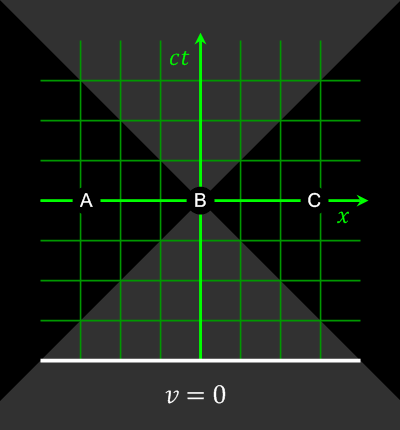Length contraction Updated 2025-07-16
Suppose that a rod has is length measured on a rest frame (or maybe even better: two identical rulers were manufactured, and one is taken on a spaceship, a bit like the twin paradox).
Question: what is the length than an observer in frame moving relative to as speed observe the rod to be?
The key idea is that there are two events to consider in each frame, which we call 1 and 2:Note that what you visually observe on a photograph is a different measurement to the more precise/easy to calculate two event measurement. On a photograph, it seems you might not even see the contraction in some cases as mentioned at en.wikipedia.org/wiki/Terrell_rotation
- the left end of the rod is an observation event at a given position at a given time: and for or and for
- the right end of the rod is an observation event at a given position at a given time : and for or and for
By plugging those values into the Lorentz transformation, we can eliminate , and conclude that for any , the length contraction relation holds:
The key question that needs intuitive clarification then is: but how can this be symmetric? How can both observers see each other's rulers shrink?
And the key answer is: because to the second observer, the measurements made by the first observer are not simultaneous. Notably, the two measurement events are obviously spacelike-separated events by looking at the light cone, and therefore can be measured even in different orders by different observers.
Light cone Updated 2025-07-16
The key insights that it gives are:
- future and past are well defined: every reference frame sees your future in your future cone, and your past in your past coneOtherwise causality could be violated, and then things would go really bad, you could tell your past self to tell your past self to tell your past self to do something.
- every other event (to right and left, known as spacelike-separated events) can be measured to happen before or after your current spacetime event by different observers.
Timelike-separated event Updated 2025-07-16
The opposite of spacelike-separated events.
Transversal time dilation Updated 2025-07-16
Light watch transverse to direction of motion. This case is interesting because it separates length contraction from time dilation completely.
Of course, as usual in special relativity, calling something "time dilation" leads us to mind boggling ideas of "symmetry breaking": if both frames have a light watch, how can both possibly observe the other to be time dilated?
And the answer to this, is the usual: in special relativity time and space are interwoven in a fucked up way, everything is just a spacetime event.
In this case, there are three spacetime events of interest: both clocks start at same position, your beam hits up at x=0, moving frame hits up at x>0.
Those two mentioned events are spacelike-separated events, and therefore even though they seem simultaneous to you, they are not going to be simultaneous to the moving observer!
If little clock one meter away from you tells you that at the time of some event (your light beam hit up) the moving light watch was only 50% up, this is just a number given by your one meter away watch!
